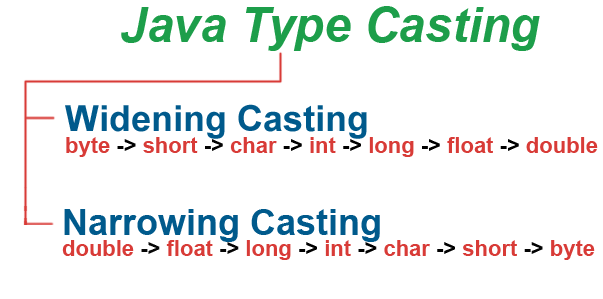As a Java programmer, you’ll often find yourself needing to convert values between different Java data types. This process, known as type casting, is a fundamental part of working with data in Java and is something every Java programmer needs to understand. In this article, we’ll go through the process of type casting in Java, explore the two main types of casting implicit and explicit, and learn when to use each one.
Type casting refers to converting a data type from one type to another.
In Java, type casting is a method or process that converts a data type into another data type in both ways manually and automatically. The automatic conversion is done by the compiler and manual conversion performed by the programmer.
The conversion of data types allows for the operations between different data types and is a crucial part of many programming tasks. For instance, you might need to convert an integer into a float for mathematical operations, or perhaps convert a string into an integer to perform some calculation.
Types of Type Casting
There are two types of type casting:
- Widening Type Casting
- Narrowing Type Casting

1. Widening Type Casting
Widening type casting, also known as implicit type casting or widening conversion, occurs when you convert a value from a smaller data type to a larger data type. In Java, widening conversions are performed automatically by the compiler because they do not involve any loss of data.
Here’s an example to illustrate widening type casting in Java
public class WideningExample {
public static void main(String[] args) {
int smallInt = 10;
long largeLong;
// Widening conversion: int to long
largeLong = smallInt;
System.out.println("smallInt: " + smallInt);
System.out.println("largeLong: " + largeLong);
}
}In this example:
- We have a variable
smallIntof typeintinitialized with the value10. - We have a variable
largeLongof typelong. - We assign the value of
smallInttolargeLong. - Since
longcan accommodate all possible values ofint, this conversion is widening and happens implicitly. - Finally, we print out both variables to see their values.
Output
smallInt: 10
largeLong: 102. Narrowing Type Casting
Narrowing type casting, also known as explicit type casting or narrowing conversion, occurs when you convert a value from a larger data type to a smaller data type. In Java, narrowing conversions may lead to loss of data and therefore require explicit casting.
Here’s an example to illustrate narrowing type casting in Java
public class NarrowingExample {
public static void main(String[] args) {
double largeDouble = 1234.5678;
int smallInt;
// Narrowing conversion: double to int
smallInt = (int) largeDouble;
System.out.println("largeDouble: " + largeDouble);
System.out.println("smallInt: " + smallInt);
}
}In this example:
- We have a variable
largeDoubleof typedoubleinitialized with the value1234.5678. - We have a variable
smallIntof typeint. - We explicitly cast
largeDoubleto anintand assign it tosmallInt. - Since
intcannot accommodate fractional values, the fractional part oflargeDoubleis truncated during the conversion. - Finally, we print out both variables to see their values.
Output
largeDouble: 1234.5678
smallInt: 1234- Let’s see some of the examples of other type conversions in Java
Example 1: Type conversion from int to String
class Main {
public static void main(String[] args) {
// create int type variable
int num = 10;
System.out.println("The integer value is: " + num);
// converts int to string type
String data = String.valueOf(num);
System.out.println("The string value is: " + data);
}
}Output
The integer value is: 10
The string value is: 10Example 2: Type conversion from String to int
class Main {
public static void main(String[] args) {
// create string type variable
String data = "10";
System.out.println("The string value is: " + data);
// convert string variable to int
int num = Integer.parseInt(data);
System.out.println("The integer value is: " + num);
}
}Output
The string value is: 10
The integer value is: 10Conclusion
In conclusion, type casting in Java is a fundamental mechanism for converting data from one type to another. It plays a crucial role in handling data of different sizes and formats within a program. Java supports both widening (implicit) and narrowing (explicit) type casting.
Widening type casting involves converting a value from a smaller data type to a larger one, which is done automatically by the compiler as it doesn’t result in loss of data. This allows for seamless integration of different data types in expressions and assignments.
On the other hand, narrowing type casting requires explicit conversion and may lead to loss of data due to truncation or overflow. Care must be taken when performing narrowing casts to ensure that the converted value fits within the range of the target data type.
While type casting provides flexibility in handling data, it also introduces risks, particularly when narrowing conversions are involved. Developers need to be mindful of potential loss of precision or unexpected behavior when converting between data types.
Overall, understanding and judicious use of type casting are essential for writing robust and efficient Java programs, ensuring data integrity while accommodating the diverse requirements of different data types.
Frequently Asked Questions
Ans: Type casting in Java refers to the conversion of one data type to another. This can be either widening (implicit) or narrowing (explicit) depending on the size of the data types involved.
Q2. What is widening type casting?
Ans: Widening type casting, also known as implicit type casting, occurs when you convert a value from a smaller data type to a larger data type. Java performs widening conversions automatically as they don’t involve loss of data.
Q3. What is narrowing type casting?
Ans: Narrowing type casting, also known as explicit type casting, occurs when you convert a value from a larger data type to a smaller data type. Java requires explicit casting for narrowing conversions as they may result in loss of data.
Q4. When should I use widening type casting?
Ans: Widening type casting is used when you want to convert a value to a larger data type without losing any information. For example, converting an int to a long or a float to a double.
Q5. When should I use narrowing type casting?
Ans: Narrowing type casting is used when you need to convert a value to a smaller data type, understanding that there may be loss of information. For example, converting a double to an int or a long to a short.
Q6. How do I perform narrowing type casting in Java?
Ans: Narrowing type casting is performed by explicitly specifying the target data type in parentheses before the value to be converted. For example: (int) doubleValue.
Q7. What happens if I attempt to narrow cast a value that is too large for the target data type?
Ans: If you attempt to narrow cast a value that is too large for the target data type, the result will be a loss of data due to truncation or overflow. Java does not perform any automatic range checking during narrowing conversions.
Q8. Can I cast between incompatible data types?
Ans: No, you cannot cast between incompatible data types in Java. Casting must be done between compatible data types, and explicit casting is required when converting between related but different types.
Q9. Is type casting reversible in Java?
Ans: Widening type casting is reversible without loss of data because it involves converting to a larger data type. However, narrowing type casting may not be reversible without potential loss of information.
Q10. What are the risks associated with type casting in Java?
Ans: The main risk associated with type casting in Java is the potential loss of data, especially when narrowing conversions are involved. It’s important to ensure that the range and precision of the source value are compatible with the target data type to avoid unintended behavior.

